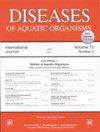寄生于丹纳蟹 Chionoecetes bairdi 的马鬃线虫(Nematomorpha),以及关于宿主与寄生虫系统发育关系的说明
IF 1.2
4区 农林科学
Q3 FISHERIES
引用次数: 0
摘要
摘要:线虫在其生命周期中利用海洋甲壳类寄主;迄今已有 16 个十足目和 1 个等足目虫属作为寄主属的报道。本研究报告了首例寄生在丹拿蟹 Chionoecetes bairdi 中的 Nectonema,增加了另一个已知的宿主属。从两只卵生雌蟹的体腔中各发现了一只线虫幼体。从 1 个 Nectonema 个体中测定了 18S rRNA 基因的核苷酸序列(1854 bp)。该 18S 序列与来自等足类宿主的 Nectonema sp.、N. agile 和 N. munidae 的 18S 序列的木村 2 参数(K2P)距离分别为 10.0%、2.0% 和 1.7%。在基于18S的树中,未知物种是由N. agile和N. munidae组成的支系的姊妹类群,这两个支系也都利用十足目寄主。寄生于十足目动物体内的3个Nectonema物种之间的系统发育关系与宿主的系统发育关系不一致,不支持线虫-宿主共同进化的假说。本文章由计算机程序翻译,如有差异,请以英文原文为准。
Nectonema horsehair worms (Nematomorpha) parasitic in the Tanner crab Chionoecetes bairdi, with a note on the relationship between host and parasite phylogeny
ABSTRACT: Nectonema nematomorphs utilize marine crustacean hosts in their life cycle; 16 decapod and 1 isopod genera have been reported to date as host genera. This study reports the first case of Nectonema parasitic in the Tanner crab Chionoecetes bairdi, adding another known host genus. A single nematomorph juvenile was recovered from the body cavity of each of 2 ovigerous female crabs. A nucleotide sequence for the 18S rRNA gene (1854 bp) was determined from 1 Nectonema individual. The 18S sequence showed Kimura 2-parameter (K2P) distances of 10.0, 2.0, and 1.7% from 18S sequences from Nectonema sp. from an isopod host, N. agile, and N. munidae, respectively. In an 18S-based tree, the unknown species was the sister taxon to a clade comprising N. agile and N. munidae, both of which also utilize decapod hosts. The phylogenetic relationships among the 3 Nectonema species parasitic in decapods were not congruent with the phylogeny of the hosts, not supporting a hypothesis of nematomorph-host co-evolution.
求助全文
通过发布文献求助,成功后即可免费获取论文全文。
去求助
来源期刊

Diseases of aquatic organisms
农林科学-兽医学
CiteScore
3.10
自引率
0.00%
发文量
53
审稿时长
8-16 weeks
期刊介绍:
DAO publishes Research Articles, Reviews, and Notes, as well as Comments/Reply Comments (for details see DAO 48:161), Theme Sections and Opinion Pieces. For details consult the Guidelines for Authors. Papers may cover all forms of life - animals, plants and microorganisms - in marine, limnetic and brackish habitats. DAO''s scope includes any research focusing on diseases in aquatic organisms, specifically:
-Diseases caused by coexisting organisms, e.g. viruses, bacteria, fungi, protistans, metazoans; characterization of pathogens
-Diseases caused by abiotic factors (critical intensities of environmental properties, including pollution)-
Diseases due to internal circumstances (innate, idiopathic, genetic)-
Diseases due to proliferative disorders (neoplasms)-
Disease diagnosis, treatment and prevention-
Molecular aspects of diseases-
Nutritional disorders-
Stress and physical injuries-
Epidemiology/epizootiology-
Parasitology-
Toxicology-
Diseases of aquatic organisms affecting human health and well-being (with the focus on the aquatic organism)-
Diseases as indicators of humanity''s detrimental impact on nature-
Genomics, proteomics and metabolomics of disease-
Immunology and disease prevention-
Animal welfare-
Zoonosis
 求助内容:
求助内容: 应助结果提醒方式:
应助结果提醒方式:


